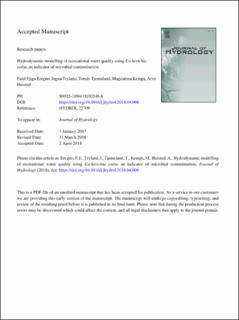| dc.contributor.author | Eregno, Fasil Ejigu | |
| dc.contributor.author | Tryland, Ingun | |
| dc.contributor.author | Tjomsland, Torulv | |
| dc.contributor.author | Kempa, Magdalena | |
| dc.contributor.author | Heistad, Arve | |
| dc.date.accessioned | 2021-12-08T13:55:33Z | |
| dc.date.available | 2021-12-08T13:55:33Z | |
| dc.date.created | 2018-07-10T11:29:24Z | |
| dc.date.issued | 2018 | |
| dc.identifier.citation | Journal of Hydrology. 2018, 561 179-186. | |
| dc.identifier.issn | 0022-1694 | |
| dc.identifier.uri | https://hdl.handle.net/11250/2833393 | |
| dc.description.abstract | Microbial contamination of recreational beaches is often at its worst after heavy rainfall events due to storm floods that carry fecal matter and other pollutants from the watershed. Similarly, overflows of untreated sewage from combined sewerage systems may discharge directly into coastal water or via rivers and streams. In order to understand the effect of rainfall events, wind-directions and tides on the recreational water quality, GEMSS, an integrated 3D hydrodynamic model was applied to assess the spreading of Escherichia coli (E. coli) at the Sandvika beaches, located in the Oslo fjord. The model was also used to theoretically investigate the effect of discharges from septic tanks from boats on the water quality at local beaches. The model make use of microbial decay rate as the main input representing the survival of microbial pathogens in the ocean, which vary widely depending on the type of pathogen and environmental stress. The predicted beach water quality was validated against observed data after a heavy rainfall event using Nash-Sutcliffe coefficient (E) and the overall result indicated that the model performed quite well and the simulation was in – good agreement with the observed E. coli concentrations for all beaches. The result of this study indicated that: 1) the bathing water quality was poor according to the EU bathing water directive up to two days after the heavy rainfall event depending on the location of the beach site. 2) The discharge from a boat at 300-meter distance to the beaches slightly increased the E. coli levels at the beaches. 3) The spreading of microbial pathogens from its source to the different beaches depended on the wind speed and the wind direction. | |
| dc.description.abstract | Hydrodynamic modelling of recreational water quality using Escherichia coli as an indicator of microbial contamination | |
| dc.language.iso | eng | |
| dc.title | Hydrodynamic modelling of recreational water quality using Escherichia coli as an indicator of microbial contamination | |
| dc.type | Peer reviewed | |
| dc.type | Journal article | |
| dc.description.version | acceptedVersion | |
| dc.source.pagenumber | 179-186 | |
| dc.source.volume | 561 | |
| dc.source.journal | Journal of Hydrology | |
| dc.identifier.doi | 10.1016/j.jhydrol.2018.04.006 | |
| dc.identifier.cristin | 1596520 | |
| dc.relation.project | Norges forskningsråd: 208279 | |
| dc.relation.project | Regionale forskningsfond Hovedstaden: 217576/97227 | |
| cristin.unitcode | 192,15,2,0 | |
| cristin.unitcode | 192,15,0,0 | |
| cristin.unitname | Seksjon for bygg og miljøteknikk | |
| cristin.unitname | Realfag og teknologi | |
| cristin.ispublished | true | |
| cristin.fulltext | postprint | |
| cristin.qualitycode | 2 | |
